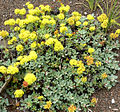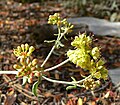|
Eriogonum umbellatum
Eriogonum umbellatum is a species of wild buckwheat known by the common name sulphurflower buckwheat, or simply sulphur flower. DescriptionIt is an extremely variable plant and hard to identify because individuals can look very different from one another. Also, there are many varieties. It may be a perennial herb blooming by summer[1] with stems 10 centimetres (4 in) tall[citation needed] and two to six clusters of flowers, with a whorl of leaves below the stems,[1] or a sprawling shrub approaching 2 metres (6+1⁄2 ft) high and wide.[citation needed] The leaves are usually woolly and low on the plant, and the flowers come in many colors from white to bright yellow to purple. Varieties
Distribution and habitatIt is native to western North America from California to Colorado to central Canada, where it is abundant and found in many habitats, including the sagebrush steppe and alpine areas.[1] EcologyIt is a popular larval host, feeding the bramble hairstreak, desert green hairstreak, lupine blue, Mormon metalmark, Rocky Mountain dotted blue, Sheridan's hairstreak, Sonoran metalmark, and western green hairstreak.[2] Additionally, goats and domestic sheep feed on the plant.[3] CultivationThe wildflower gardening author Claude A. Barr complemented sulphurflower buckwheat as a "treasure in appearance and in adaptation in my garden."[4] It is valued for its very low water usage for xeriscaping. The cultivar "Kannah Creek", a selection of Eriogonum umbellatum var. aureum, has been introduced to the garden trade by the Plant Select cooperative sponsored by Colorado State University and Denver Botanic Gardens.[5][6] It grows in USDA zones 4–8.[7]
References
External links
|
||||||||||||||||||||||||||||||||
Portal di Ensiklopedia Dunia








